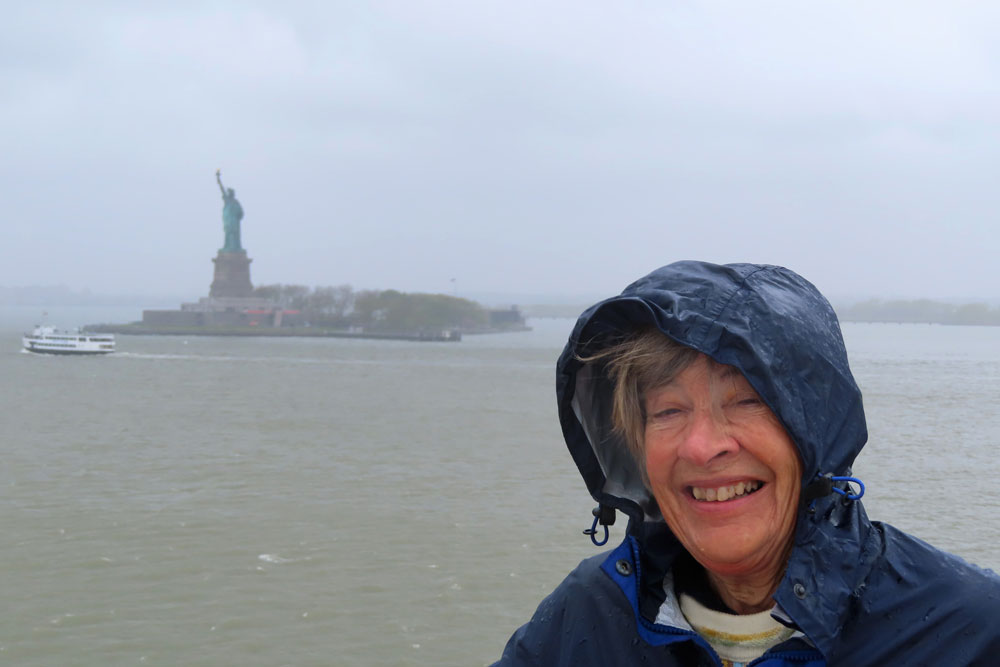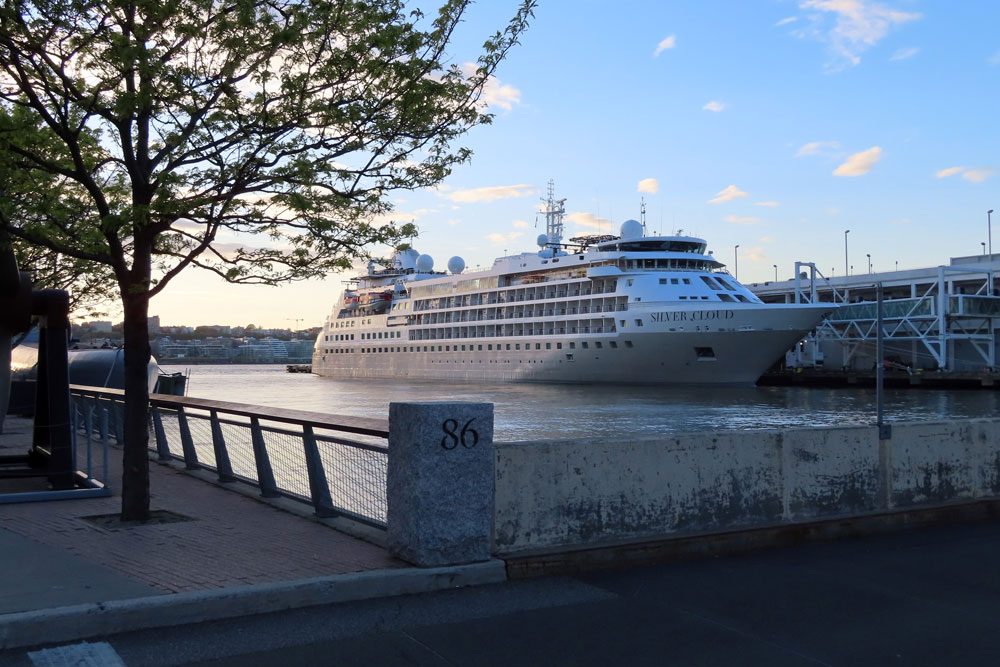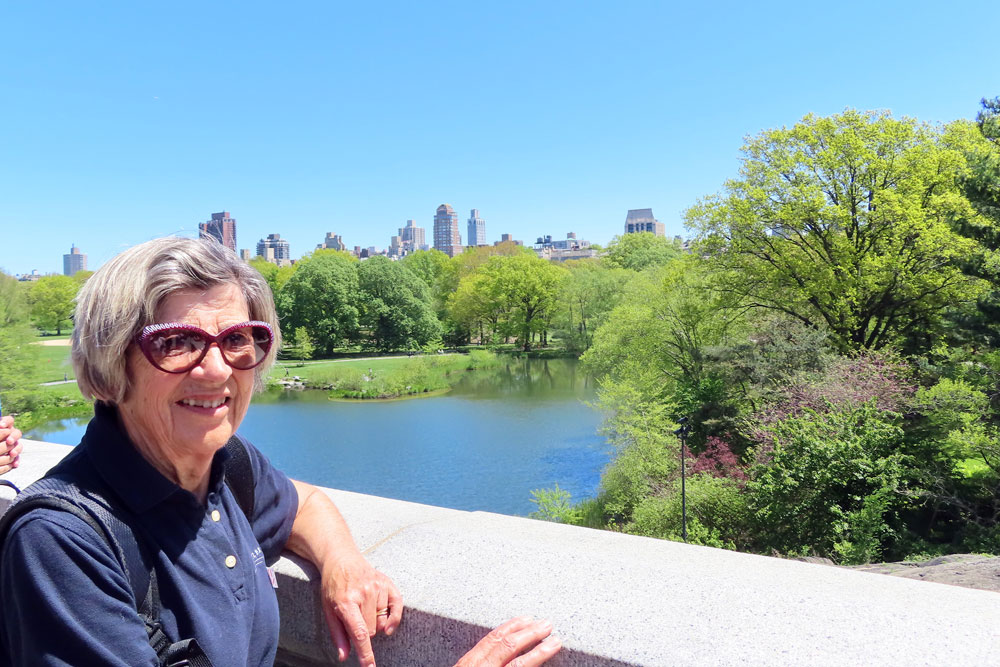


A gathering storm forced the ship to abandon the scheduled stops at Baltimore and Norfolk, Virginia. And we ended up at pier 88 in New York for 4 whole nights. The first day in the wet we got tickets for the neighbouring Aircraft Carrier museum (unescorted, make your own way there). Then we had two very similar bus tours, each keen to show us where Jacqueline Kennedy walked her dog, and where unknown "movie stars" lived. One did include the World Trade centre site.
Arriving and Leaving New York
Certainly passing the Statue of Liberty was an iconic moment, with virtually all the crew, and passengers on deck for the regulation photos
Click on any thumbnail photo and get a larger photo
 |
 |
 |
 |
 |
 |
 |
 |
 |
 |
The USS Intrepid Museum

The USS Intrepid is a laid up US Navy carrier. It is one of 24 Essex-class aircraft carriers built during World War II for the United States Navy. She is the fourth US Navy ship to bear the name. Commissioned in August 1943, Intrepid participated in several campaigns in the Pacific Theater of Operations, including the Battle of Leyte Gulf. Decommissioned shortly after the end of the war, she was modernized and recommissioned in the early 1950s as an attack carrier (CVA), and then eventually became an antisubmarine carrier (CVS). In her second career, she served mainly in the Atlantic, but also participated in the Vietnam War. She was the recovery ship for a Mercury and a Gemini space mission. Because of her prominent role in battle, she was nicknamed "the Fighting I", while her frequent bad luck and time spent in dry dock for repairs—she was torpedoed once and hit in separate attacks by four Japanese kamikaze aircraft—earned her the nicknames "Decrepit" and "the Dry I". Decommissioned for the second time in 1974, in 1982 Intrepid became the foundation of the Intrepid Sea, Air & Space Museum in New York City.
Click on any thumbnail photo and get a larger photo
 |
 |
 |
 |
 |
 |
 |
 |
 |
 |
 |
 |
Top of the Rock. The Rockefeller Centre

We took the high speed elevator to "the top of the Rock", which indeed offer spectacular views over Central Park and the City. Included is a good example of the power of a telephoto lens, where the Statue of Liberty , a dot to the naked eye, is clearly seen in the camera. Incidentally the iconic "construction workers on the girder" was shot during the building of the Rockefeller Centre
Click on any thumbnail photo and get a larger photo
 |
 |
 |
 |
 |
 |
 |
 |
 |
 |
Touring round New York.
St Patrick's Cathedral, Central Station, UN Building and Time Square
Click on any thumbnail photo and get a larger photo
 |
 |
 |
 |
 |
 |
 |
 |
 |
 |
 |
 |
 |
 |
 |
 |
 |
 |
 |
 |
 |
 |
 |
 |
 |
 |
 |
 |
 |
 |
 |
 |
 |
 |
 |
 |
 |
 |
 |
 |
The 9/11 Memorial
The National September 11 Memorial & Museum commemorates the September 11, 2001 attacks, which killed 2,977 people. The memorial is located at the World Trade Centre site, the former location of the Twin Towers. It is operated by a non-profit institution whose mission is to raise funds for, program, and operate the memorial and museum at the World Trade Centre site. A memorial was planned in the immediate aftermath of the attacks and destruction of the World Trade Centre for the victims and those involved in rescue and recovery operations.
The winner of the World Trade Centre Site Memorial Competition was Israeli-American architect Michael Arad. Arad worked with landscape-architecture firm Peter Walker and Partners on the design, creating a forest of swamp white oak trees with two square reflecting pools in the centre marking where the Twin Towers stood. In August 2006, the World Trade Centre Memorial Foundation began heavy construction on the memorial and museum. A dedication ceremony commemorating the tenth anniversary of the attacks was held at the memorial on September 9, 2011, and it opened to the public the following day. The museum was dedicated on May 15, 2014, with remarks from then mayor of New York City, Michael Bloomberg, and then President, Barack Obama.

Click on any thumbnail photo and get a larger photo
 |
 |
 |
 |
 |
 |
 |
 |
 |
 |
The High Line Garden
The High Line is a 1.45-mile-long) elevated linear park, greenway and rail trail created on a former New York Central Railroad spur on the west side of Manhattan in New York City. The abandoned spur has been redesigned as a "living system" drawing from multiple disciplines which include landscape architecture, urban design, and ecology. The High Line was inspired by the 2.9 mi long Promenade plantée (tree-lined walkway), a similar project in Paris completed in 1993.
The park is built on a disused, southern viaduct section of the New York Central Railroad's West Side Line. Originating in the Meatpacking District, the park runs from Gansevoort Street – three blocks below 14th Street – through Chelsea to the northern edge of the West Side Yard on 34th Street near the Javits Centre. The West Side Line formerly extended south to a railroad terminal at Spring Street, just north of Canal Street, and north to 35th Street at the site of the Javits Centre Due to a decline in rail traffic along the rest of the viaduct, it was effectively abandoned in 1980 when the construction of the Javits Centre required the demolition of the viaduct's northernmost portion.
The southern portion of the viaduct was demolished in segments during the late 20th century. Re purposing the railway into an urban park began in 2006 and opened in phases during 2009, 2011, and 2014. The Spur, an extension of the High Line that originally connected with the Morgan General Mail Facility at Tenth Avenue and 30th Street, opened on June 4, 2019, as the final part of the park to open. Since opening in June 2009, the High Line has become an icon of American contemporary landscape architecture. The High Line's success has inspired cities throughout the United States to redevelop obsolete infrastructure as public space. The park became a tourist attraction and spurred real estate development in adjacent neighbourhoods, increasing real-estate values and prices along the route. By September 2014, the park had nearly five million visitors annually, and by 2019, it had eight million visitors per year.

Click on any thumbnail photo and get a larger photo
 |
 |
 |
 |
 |
 |
 |
 |
 |
 |
The Met.

We were supposed to have a private tour before the general opening, but for undisclosed reasons, we were just plonked here mid morning in the normal queue, and left to ourselves for a couple of hours, without a guide. Choosing at random, we headed for the Egyptian collection, and then gravitated to the iconic Washington crossing the Delaware, There were interesting asides with modern cartoons based on the original.
Click on any thumbnail photo and get a larger photo
 |
 |
 |
 |
 |
 |
 |
 |
 |
 |
 |
 |
Central Park - A walk in the park.

Central Park lies between the Upper West and Upper East Sides of Manhattan. It covers 843 acres. It is the most visited urban park in the United States, with an estimated 42 million visitors annually as of 2016. After proposals for a large park in Manhattan during the 1840s, it was approved in 1853 to cover 778 acres . In 1857, landscape architects Frederick Law Olmsted and Calvert Vaux won a design competition for the park with their "Greensward Plan". Construction began the same year; existing structures, including a majority-Black settlement named Seneca Village, were seized through eminent domain and razed. The park's first areas were opened to the public in late 1858. Additional land at the northern end of Central Park was purchased in 1859, and the park was completed in 1876. After a period of decline in the early 20th century, New York City parks commissioner Robert Moses started a program to clean up Central Park in the 1930s.
The Central Park Conservancy, created in 1980 to combat further deterioration in the late 20th century, refurbished many parts of the park starting in the 1980s. Main attractions include landscapes such as the Ramble and Lake, Hallett Nature Sanctuary, the Jacqueline Kennedy Onassis Reservoir, and Sheep Meadow; amusement attractions such as Wollman Rink, Central Park Carousel, and the Central Park Zoo; formal spaces such as the Central Park Mall and Bethesda Terrace; and the Delacorte Theater. The biologically diverse ecosystem has several hundred species of flora and fauna. Recreational activities include carriage-horse and bicycle tours, bicycling, sports facilities, and concerts and events such as Shakespeare in the Park. Central Park is traversed by a system of roads and walkways and is served by public transportation.
Its size and cultural position make it a model for the world's urban parks. Its influence earned Central Park the designations of National Historic Landmark in 1963 and of New York City scenic landmark in 1974. Central Park is owned by the New York City Department of Parks and Recreation but has been managed by the Central Park Conservancy since 1998, under a contract with the municipal government in a public–private partnership. The Conservancy, a non-profit organization, raises Central Park's annual operating budget and is responsible for all basic care of the park. For Chris, Central Park was the saving grace of our enforced 4 night stay in New York.
Click on any thumbnail photo and get a larger photo
 |
 |
 |
 |
 |
 |
 |
 |